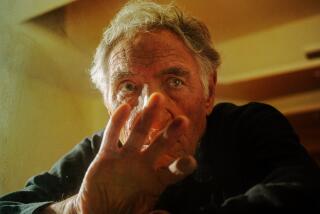An appreciation: Annette Funicello, comfortable being herself
- Share via
As a merry Mouseketeer and then as a big-screen beach bunny, Annette Funicello, who died Monday at age 70, was the first love for a couple of generations of young Americans. (Perhaps not exclusively male Americans, but people were more tight-lipped about these things in those days.) In her own, small way, she is as memorable a monument of mid-20th-century American womanhood as Marilyn Monroe or Doris Day.
Teenage stars, especially those who come out of television, or whose recording careers are presided over by professional hitmakers, are often and often unfairly described as “manufactured,” however many records they sell or lives they enliven. (In the ‘90s, Disney’s reborn “Mickey Mouse Club” produced Britney Spears, Justin Timberlake and Christina Aguilera.) But while presence can be exploited and shaped, it can’t be made. Funicello’s stardom was born of the intersection of her native gifts, rare opportunity and a cultural moment. But even if you did not grow up under her spell, it’s not hard, looking back on her best work — most of it for Disney — to fall for her even now.
Funicello — it is difficult not to write simply “Annette” in referring to her — was not, certainly, an outsized talent, and it was part of her charm that she never tried to pretend otherwise. (Of her singing: “My voice is very small,” she told an interviewer later in life, with “a range of about three notes.”) Her early acting has the measured, word-by-word delivery of the amateur, but it is couched in an appealing softness; at her most awkward, she is never less than vibrant.
PHOTOS: Annete Funicello - Career in pictures
The young Annette combined modesty and openness, demureness and directness. She had an ability to engage a viewer through a camera — one might call it pre-flirtatious — that came from somewhere outside of show business. The nation responded, and Disney made much of use of her, on the small screen and the large.
Her Italian looks — dark skin, thick curly hair — set her apart from her fellow Mousketeers. She was an exotic: pubescent kin to Sophia Loren. (In the 1958 “Mickey Mouse Club” serial that bore her name, she played a country girl in the city, which now seems like a metaphor for her otherness.) Disney used her as a Mexican-American in a couple of episodes of the series “Zorro” and the TV miniseries “Elfego Baca: Attorney at Law” and let her own roots showed through in “Escapade in Florence.”
Interestingly, the Disney version seems more lifelike now than the more mature but highly varnished Annette of the beach movies. Although they are generally limited by contemporary notions of acceptable family fare and cultural wishful thinking about the thoughts and activities of teenagers, the Disney films and TV shows that featured her have an unaffected quality, based possibly in a reticence, less felt nowadays, to turn children into adults. They let the inner Funicello shine through.
PHOTOS: Disney’s Mousketeers over the years
Notwithstanding a smattering of guest shots on episodic television and variety shows and an appealing series of commercials for Skippy peanut butter (Annette in a casual, motherly mode), her career proper lasted only a decade and change; her brand was not made to survive the culture wars of the late ‘60s and early ‘70s, and one guesses that her stardom did not matter enough for her to scramble to extend it, a lack of desperation that made her semi-retirement, finally sealed by her advancing MS, seem gracious and graceful.
When she did dip back into show business, it was often in some way that directly or indirectly referred, with modest good humor, to her old onscreen persona. It was in 1987, touring with Frankie Avalon, promoting “Back to the Beach,” the New Wave surf-nostalgia movie in which they co-starred that she first noticed the symptoms of MS. It was not until 1992 that she revealed her diagnosis, to combat rumors of drunkenness, but she remained open and out in the open for a long time afterward, putting a face on the disease in a way that seemed as unself-conscious as the work we remember her for.
PHOTOS, VIDEOS & MORE:
Real places, fake characters: TV’s bars and eateries
PHOTOS: ‘The Ellen DeGeneres Show’ through the years
PHOTOS: Violence in TV shows
More to Read
The complete guide to home viewing
Get Screen Gab for everything about the TV shows and streaming movies everyone’s talking about.
You may occasionally receive promotional content from the Los Angeles Times.







